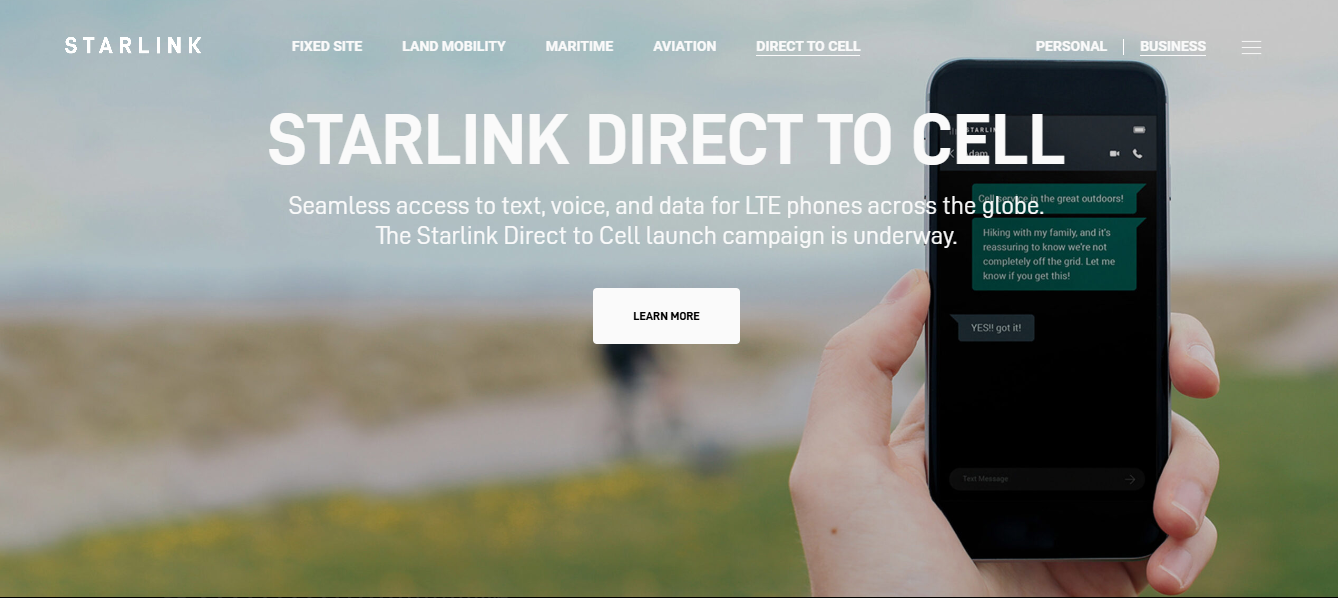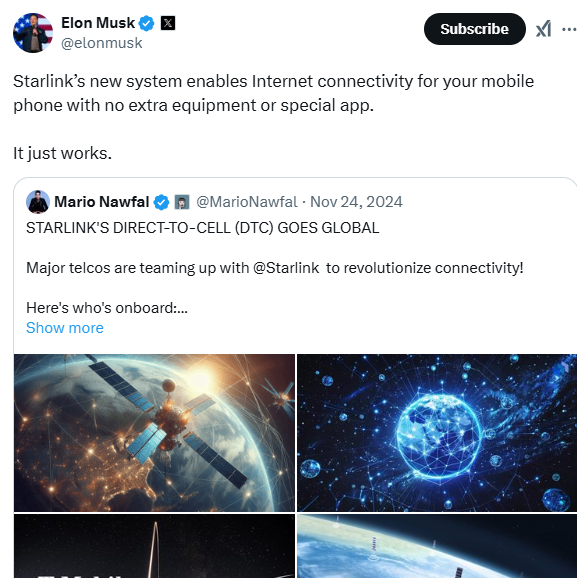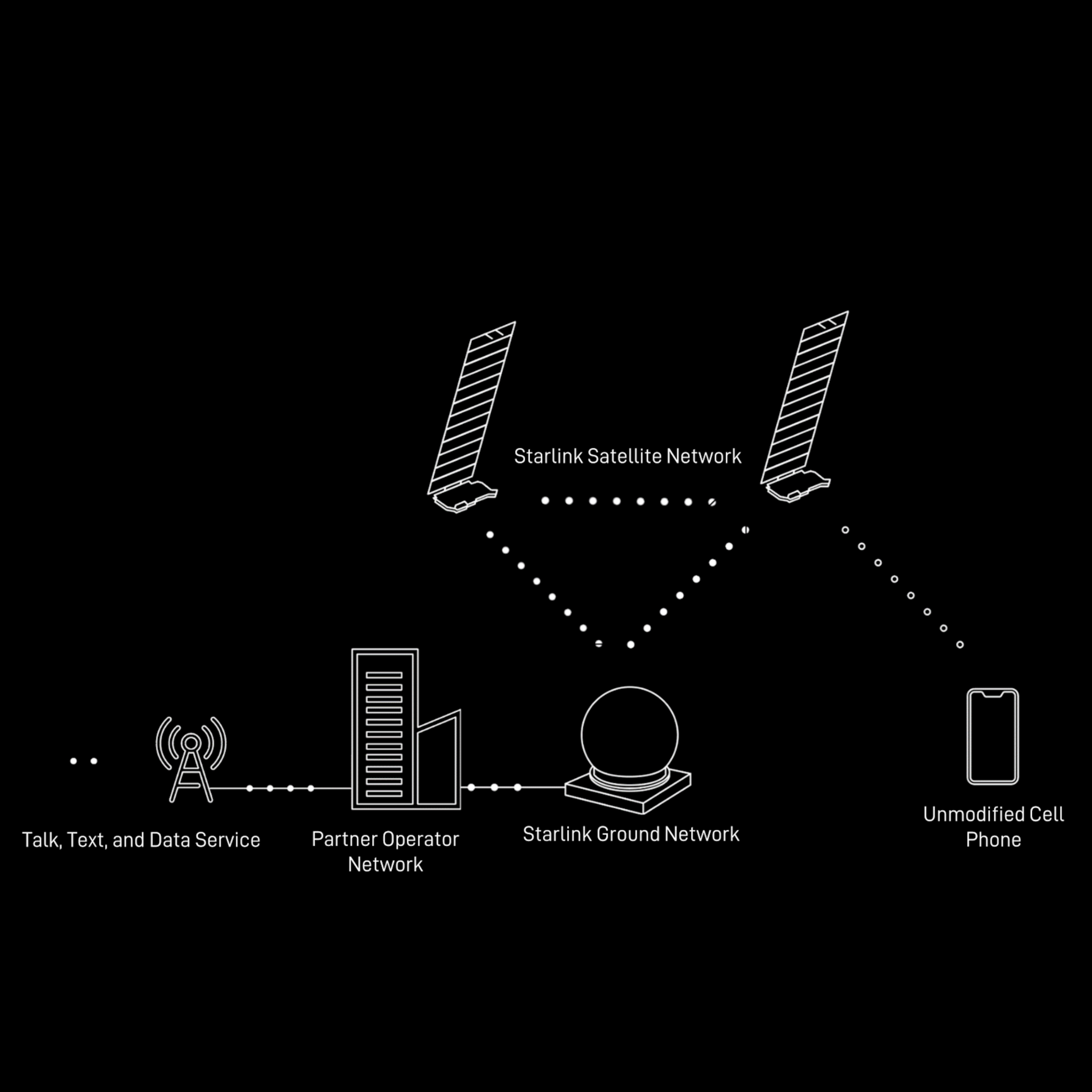This page has moved. If you are not redirected, click here.
Starlink's Direct to Cell: Revolutionizing Mobile Connectivity
In a groundbreaking move, SpaceX’s Starlink has introduced its Direct to Cell service, a satellite-based mobile connectivity solution that eliminates the need for traditional cell towers. This innovative technology enables standard LTE-compatible smartphones to connect directly to Starlink satellites, ensuring seamless communication even in the most remote areas of the world.

Elon musk tweeted: “Starlink’s new system enables Internet connectivity for your mobile phone with no extra equipment or special app.
It just works.”

What is Starlink Direct to Cell?
Starlink Direct to Cell leverages SpaceX’s advanced satellite network to provide global mobile connectivity. Equipped with eNodeB modems, Starlink satellites function as “cell towers in space,” enabling users to send texts, make calls, and access data services without requiring any additional hardware, firmware updates, or special apps. All you will need is your current LTE-enabled smartphone and a clear view of the sky.
Key Features
- Universal Compatibility: Works with existing LTE smartphones and IoT devices using standard LTE protocols.
- Global Coverage: Provides connectivity in remote regions, including mountains, oceans, and rural areas where traditional networks fail.
- No Extra Equipment: No need for additional devices or apps—just your phone.
- Future Expansion: Initially focused on text messaging, the service will expand to include voice and data capabilities by 2025.
How Does It Work?
“Starlink satellites with Direct to Cell capability have an advanced eNodeB modem onboard that acts like a cellphone tower in space, allowing network integration similar to a standard roaming partner.”, according to SpaceX.
Starlink satellites equipped with Direct to Cell technology act as roaming partners for mobile networks. These satellites communicate directly with phones on the ground, bypassing the need for terrestrial cell towers. The system integrates seamlessly with participating telecom carriers, such as T-Mobile in the U.S., Rogers in Canada, KDDI in Japan, and others globally.
The satellites operate in low Earth orbit (LEO), which reduces latency compared to traditional satellite systems. This ensures faster and more reliable connections for users.

Current Availability and Rollout
As of early 2025, Starlink Direct to Cell is available in several countries, including:
- The United States (via T-Mobile)
- Canada
- Australia
- New Zealand
- Japan
- Switzerland
- Chile
- Peru
- Ukraine
A beta test for text messaging began in late 2024 with plans to expand services in 2025. Voice and data functionalities are expected later this year as SpaceX continues deploying its Gen2 satellites equipped with Direct to Cell payloads.
Potential Impact
Starlink Direct to Cell has the potential to bridge the digital divide by providing connectivity in areas previously inaccessible due to lack of infrastructure. This technology could:
- Enhance emergency communication during natural disasters.
- Support businesses and communities in rural or underserved regions.
- Provide peace of mind for travelers and adventurers venturing into remote locations.
- Enable IoT applications in agriculture, logistics, and environmental monitoring.
According to their website: “In addition to expanding mobile coverage, Direct to Cell will enable ubiquitous Internet of Things (IoT) connectivity outside of terrestrial coverage, connecting millions of devices across critical global industries.
• No specialized or additional hardware required • Compatible with off-the-shelf CAT-1, CAT-1 Bis, and CAT-4 modems”
5. Starlink’s Direct-to-Cell (DTC) technology, as mentioned by Elon Musk, is part of a broader initiative involving major telecommunications companies globally to enhance mobile network coverage by eliminating dead zones through satellite connectivity.
Challenges and Limitations
While revolutionary, there are some limitations:
- Bandwidth Constraints: Satellite bandwidth is shared among users, making it less competitive with terrestrial networks in urban areas.
- Regulatory Approvals: Deployment depends on obtaining permissions from local regulators.
- Cost Uncertainty: Pricing details for end-users remain unclear as the service rolls out globally.
The Future of Connectivity
By combining cutting-edge satellite technology with existing mobile infrastructure, Starlink’s Direct to Cell service represents a significant leap forward in global communication. As SpaceX continues expanding its satellite constellation and forging partnerships with telecom carriers worldwide, the dream of universal mobile connectivity is closer than ever.
References
- Starlink Business - Direct To Cell
- Satellite Internet - Starlink Direct to Cell
- SpaceNews - SpaceX Gets Conditional Approval
- The Register - Ukraine to Get Starlink Direct-to-Cell
- Prysmian - Starlink Preparing Satellite-Based 4G Service
- T-Mobile and Starlink satellite connectivity explained: What you need to know
Citations:
[1] https://www.satelliteinternet.com/resources/starlink-direct-to-cell/
[2] https://www.starlink.com/business/direct-to-cell
[3] https://spacenews.com/spacex-gets-conditional-approval-for-direct-to-smartphone-service/
[4] https://technology.inquirer.net/139593/starlinks-direct-to-cell-to-enable-free-global-calls-and-texts
[5] https://www.theregister.com/2025/01/01/starlink_directtocell_ukraine/
[6] https://www.veon.com/newsroom/press-releases/in-a-groundbreaking-agreement-veon-and-starlink-to-bring-starlink-direct-to-cell-satellite-connectivity-to-kyivstar-customers
[7] https://www.prysmian.com/en/insight/telecoms/nexst/starlink-4g-mobile-service
[8] https://www.yahoo.com/tech/spacex-cellular-starlink-ready-154854580.html
[9] https://spacenews.com/new-zealand-first-to-offer-nationwide-direct-to-smartphone-starlink-service/
[10] https://newsroom.kddi.com/english/news/detail/kddi_nr-299_3557.html